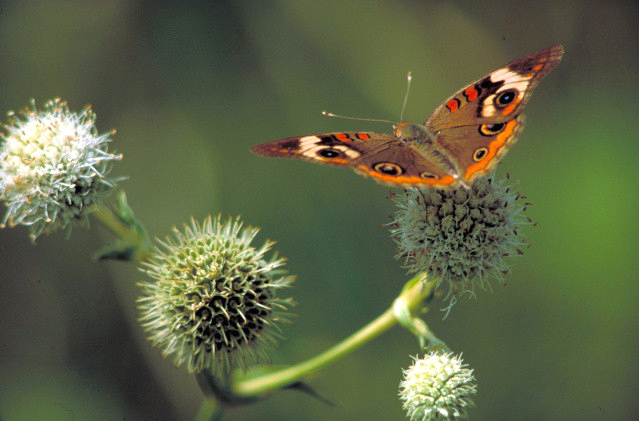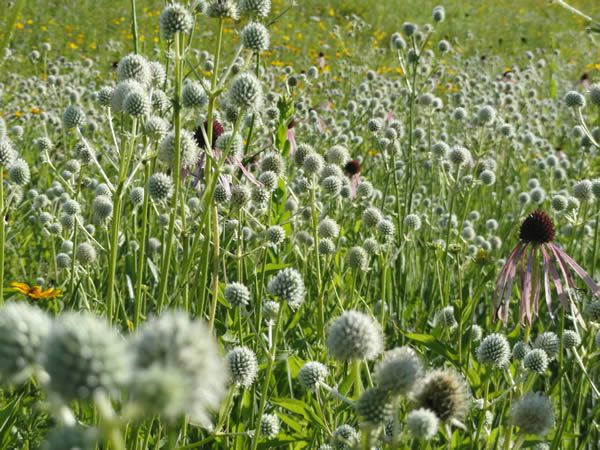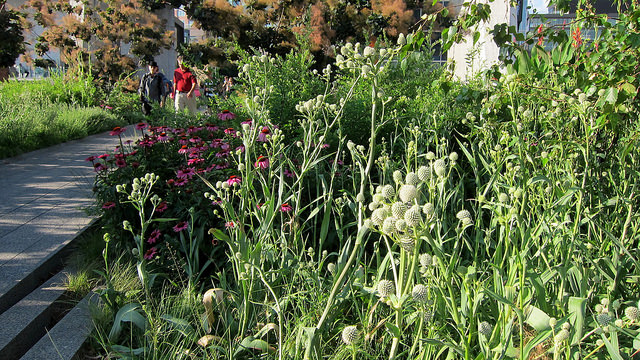In celebration of National Wildflower Week, we're highlighting some of our favorite "weird and wonderful" plants for pollinators. You can find the best plants for pollinators anytime with our plant lists.
Rattlesnake Master
Eryngium yuccifolium
Everything about rattlesnake master is a bit peculiar. The plants grow in the prairies and meadows of the eastern U.S., yet look like they belong with the tumbleweed and cactus of the Desert Southwest. A member of the carrot family, rattlesnake master is a doppelganger for yucca plants of the lily family (the latin name, Eryngium yuccifolium alludes to the resemblance).
Flowers in the carrot family have dainty flowers arranged in umbels, think fennel, dill, or Queen Anne's lace. Rattlesnake master bucks this trend with composite flowers closely packed together around a globe. More "golf ball" than "umbrella-like" in appearance.
And oh what flowers. One flower stalk can have between ten and forty flowerheads, with each flowerhead averaging 106 individual flowers - meaning a single plant can produce between 1,060 and 4,240 individual flowers!

When in bloom, rattlesnake master has few rivals for its ability to attract a diversity of floral visitors. Bumble bees, yellow-faced bees (Hylaeus spp.), sweat bees (Lassioglossum spp.), multiple beetles and dozens of fly species regularly visit the plant. The plant is a host for the Eryngium stem-borer moth (Papaipema eryngii) - a candidate for endangered species listing, and the flower feeding moth (Coleotechnites eryngiella).
With all those floral visitors, it’s not surprising the plant is a favorite amongst predatory wasps. Heather Holm’s fantastic Pollinators of Native Plants documents 11 types of wasps who visit the plant including grass-carrying wasps (Isodontia spp.), paper wasps (Polistes spp.), Mason wasps (Ancistrocerus spp.), thread-waisted wasps (Prionyx spp.) and great golden digger wasps (Spex ichneumoneus) - a fantastic find to behold! While wasps are much-maligned, many of the species mentioned here are non-aggressive, and incredibly beneficial predators of pests such as aphids. The plant may even attract specialist wasps that aid with the control of the brown marmorated stink bug.

Just because the flowers and foliage are unusual doesn’t mean the plant has to look out of place in a garden setting. Rattlesnake master mixes well with the grass-like leaves and flower spikes of blazingstar (Liatris spp.), or with sea holly - a closely related Eryngium spp. It would also look right at home with purple coneflower and black-eyed susans which bloom at the same time and have heights that would be complementary to rattlesnake master.

As for that common name - Native Americans used the plant for various medicinal purposes, leading pioneers to (erroneously) believe the plant to be an antidote to rattlesnake venom.
Best For: Attracting an astounding diversity of pollinators, including predatory wasps for natural pest control, supporting an at-risk species of moth.
Native Range: Most of the state east of the Mississippi River, from the Great Lakes and mid-Atlantic region, south to Texas and Florida.




